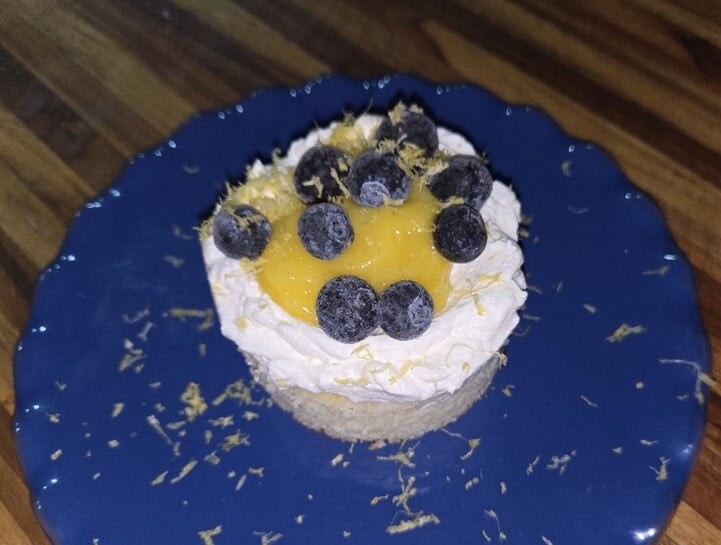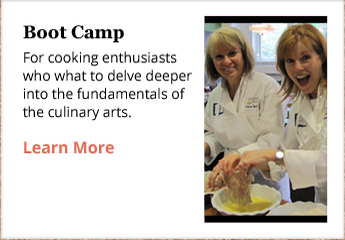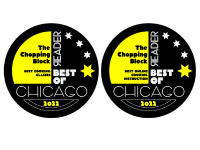Lemons truly rule in the Spring! Their bright yellow color reminds me that Summer is only a heartbeat away, their zip and tang reminds me how good cold lemonade is on a hot day, and lemon desserts just seem to be a lovely light ending to a special meal. I’ve written before about how I love preparing Easter dinner, focusing on the beauty of Spring: everything is new again! I can’t recall an Easter dinner where I haven’t prepared a dessert that includes lemon flavors, so I thought I would share a favorite with you.
 I start with a lemon pound cake recipe that I’ve used for so many years, I can’t even remember where it originally came from! I love the density of the crumb and, of course, the lemon flavor. But instead of baking it in a loaf pan, I adapted it to bake in a quarter-sheet pan (any 9”x13” pan will do just as well). Then I cut rounds of cake for individual servings, top them generously with whipped cream, add a dollop of lemon curd, and toss on whatever berries I have on hand. Individual desserts are so much fun, and they lend a very special feel to the end of a meal. But here’s the real beauty of this dessert: while you can make as much of it from scratch as you wish (I’ll show you the cake and lemon glaze here), you can also put it together from store-bought pound cake (it may not be lemon, but you can jazz it up with the lemon glaze) and store-bought lemon curd. And, while I really do recommend whipping your own cream, you do you if a spray of Reddi Wip is more your thing!
I start with a lemon pound cake recipe that I’ve used for so many years, I can’t even remember where it originally came from! I love the density of the crumb and, of course, the lemon flavor. But instead of baking it in a loaf pan, I adapted it to bake in a quarter-sheet pan (any 9”x13” pan will do just as well). Then I cut rounds of cake for individual servings, top them generously with whipped cream, add a dollop of lemon curd, and toss on whatever berries I have on hand. Individual desserts are so much fun, and they lend a very special feel to the end of a meal. But here’s the real beauty of this dessert: while you can make as much of it from scratch as you wish (I’ll show you the cake and lemon glaze here), you can also put it together from store-bought pound cake (it may not be lemon, but you can jazz it up with the lemon glaze) and store-bought lemon curd. And, while I really do recommend whipping your own cream, you do you if a spray of Reddi Wip is more your thing!
So, let’s get started on that cake! For the cake, you will need unsalted butter, cake flour, baking powder, salt, sugar, lemon zest, lemon juice, eggs, and vanilla. For the glaze, you will need sugar and lemon juice. Note that the ingredient quantities listed in the recipe that follows are less than what you see in the photo above. I also needed to bake a full lemon pound cake, so I made the batter and glaze for both cakes at once; that’s what you see pictured. Rest assured that the recipe, as written, is for the cake and glaze for these individual dessert cakes only.
 In this photo of my mise-en-place, I already whisked together the cake flour, baking powder, and salt in one bowl. I have sugar in two separate bowls: one is marked “cake” and one marked “syrup”. When using the same ingredient in two different preparations, I’ve mixed them up too often to not label them, so I highly recommend doing so – you can thank me later!
In this photo of my mise-en-place, I already whisked together the cake flour, baking powder, and salt in one bowl. I have sugar in two separate bowls: one is marked “cake” and one marked “syrup”. When using the same ingredient in two different preparations, I’ve mixed them up too often to not label them, so I highly recommend doing so – you can thank me later!
You will also see that I included a jar of lemon curd in the photo. You will need lemon curd only for assembling the finished dessert. As I mentioned, you can certainly purchase it. However, if you choose to make your own, I suggest you take a look at Chef Sara’s lemon curd recipe in this blog, where she starts with making lemon curd before turning it into gorgeous lemon mousse. Likewise, I did not include details on making your own whipped cream, but if you read Chef Sara’s post further, you’ll see how simple it is to do! She whipped it by hand but, if you wish, you can use an electric mixer to make the process move along a little faster. And here’s a helpful hint for making it ahead of time: Add a spoonful of mascarpone or cream cheese as you’re whipping the cream to help stabilize it. Store it in the fridge, and it will be ready to go when you are!
Preheat the oven to 350⁰ F and prepare your pan. You’ll need a quarter-sheet pan – which is really just a shallow version of a 9”x13” pan. I compared the sizes for you here:
 You’ll want to butter the pan and dust it with cake flour, tapping out the excess, and line the bottom with a piece of parchment. The quarter-sheet pan in the photo has already been prepared in this way.
You’ll want to butter the pan and dust it with cake flour, tapping out the excess, and line the bottom with a piece of parchment. The quarter-sheet pan in the photo has already been prepared in this way.
Whisk together 170 g/6 oz/ 1.5 cup cake flour, 1 teaspoon baking powder and 1/2 teaspoon salt in a medium bowl and set aside.
Next, gently melt 2 sticks/16 Tablespoons butter in a small saucepan over low heat. Alternatively, you can put the butter in a microwave-safe measuring cup and melt it in the microwave. I realize that I dirtied an extra pan by melting it on my stovetop and then transferring it into a measuring cup for pouring later but, for me, I can keep a better eye on it when it’s right in front of me. I like to let the butter melt to where there are a few small pieces left, then turn off the heat and stir/whisk them until they melt completely. This keeps the butter from getting too hot.
 While your butter is melting, zest 2 medium lemons. You will need 2 Tablespoons of zest, so two lemons should do the trick. Keep in mind that it’s much easier to zest lemons before cutting them in half to juice them. A Microplane is perfect for this task, letting the zest accumulate in the top part. Just remember to run it over each area only once to ensure that you are getting only the outer zest and not the bitter white pith underneath.
While your butter is melting, zest 2 medium lemons. You will need 2 Tablespoons of zest, so two lemons should do the trick. Keep in mind that it’s much easier to zest lemons before cutting them in half to juice them. A Microplane is perfect for this task, letting the zest accumulate in the top part. Just remember to run it over each area only once to ensure that you are getting only the outer zest and not the bitter white pith underneath.
 Cut the lemons in half and juice them. You’ll only need 2 teaspoons of juice, so start with just one lemon. Depending on their size, one may be enough. If you don’t need to juice the second lemon, just wrap it tightly in plastic wrap and set it aside until you need it for something else (like the glaze later on).
Cut the lemons in half and juice them. You’ll only need 2 teaspoons of juice, so start with just one lemon. Depending on their size, one may be enough. If you don’t need to juice the second lemon, just wrap it tightly in plastic wrap and set it aside until you need it for something else (like the glaze later on).
Onto the batter! Place 248 g/8.75 oz/1.25 cup sugar and the lemon zest in the bowl of a food processor. Alternatively, you can use a blender, but mine is tucked away, so I turn to my food processor for this. Process the sugar and zest in 1-second pulses, until combined (5 or 6 pulses). I find that when I process sugar or flour with little else in my food processor it tends to billow out all over the place, so I always place a towel over the top. It saves on clean-up!
 Add the lemon juice, 4 eggs and 1.5 teaspoons vanilla. Process for about 5 seconds to mix. It will be a bit frothy.
Add the lemon juice, 4 eggs and 1.5 teaspoons vanilla. Process for about 5 seconds to mix. It will be a bit frothy.
 Now, with the food processor running, add the butter, pouring it in a steady stream through the feed tube. If you melted the butter on the stovetop, as I did, you may find it pours more easily and with less mess by transferring it to a measuring cup and then pouring it in. Regardless of how you melted the butter, give it a stir before pouring to make sure you are incorporating all the solids that may have settled to the bottom. Processing time should be about 20 seconds.
Now, with the food processor running, add the butter, pouring it in a steady stream through the feed tube. If you melted the butter on the stovetop, as I did, you may find it pours more easily and with less mess by transferring it to a measuring cup and then pouring it in. Regardless of how you melted the butter, give it a stir before pouring to make sure you are incorporating all the solids that may have settled to the bottom. Processing time should be about 20 seconds.
 Transfer the wet ingredient mixture from the food processor (or blender) to a large mixing bowl.
Transfer the wet ingredient mixture from the food processor (or blender) to a large mixing bowl.
 Now sift the flour mixture (cake flour, baking powder and salt) in three additions into the wet ingredients. Sifting the dry ingredients creates a finer crumb to the cake. It only takes a few extra minutes, but makes a big difference in texture. You can use a sifter if you have one. If not, you can use a whisk.
Now sift the flour mixture (cake flour, baking powder and salt) in three additions into the wet ingredients. Sifting the dry ingredients creates a finer crumb to the cake. It only takes a few extra minutes, but makes a big difference in texture. You can use a sifter if you have one. If not, you can use a whisk.
 I used a fine-mesh sieve and held it over the bowl with one hand (do not let it touch the wet ingredients below). With the other hand, I spooned about 1/3 of the dry ingredients into the sieve. I then used my whisk to alternately stir and tap the flour mixture through the sieve.
I used a fine-mesh sieve and held it over the bowl with one hand (do not let it touch the wet ingredients below). With the other hand, I spooned about 1/3 of the dry ingredients into the sieve. I then used my whisk to alternately stir and tap the flour mixture through the sieve.
 Then gently whisk the ingredients together to blend until just combined.
Then gently whisk the ingredients together to blend until just combined.
 Repeat this sifting and whisking two more times, scraping down the sides with the final blending. Your final batter will resemble pancake batter. It will be very fluid, but have a thickness to it.
Repeat this sifting and whisking two more times, scraping down the sides with the final blending. Your final batter will resemble pancake batter. It will be very fluid, but have a thickness to it.
 Pour the batter into the prepared pan.
Pour the batter into the prepared pan.
 Place the pan on the middle rack of your oven and set a timer for 15 minutes. Reduce the oven temperature to 325⁰ F and bake for another 12-15 minutes. Take a peek through your oven window at about the 10-minute mark, as every oven is different. You want the cake top to be deep golden brown and a skewer inserted into the center to come out clean.
Place the pan on the middle rack of your oven and set a timer for 15 minutes. Reduce the oven temperature to 325⁰ F and bake for another 12-15 minutes. Take a peek through your oven window at about the 10-minute mark, as every oven is different. You want the cake top to be deep golden brown and a skewer inserted into the center to come out clean.
 You can see that I probably left mine in a minute or two longer than necessary. However, it won’t matter in the long run, as we’ll be flipping this upside down & no one will ever be the wiser! Let the cake cool on a wire cooling rack for about 10 minutes. Then run a spatula around the outside, just to be sure the cake isn’t sticking to the sides. Move the pan to a trivet and place the wire rack upside down on top of the cake.
You can see that I probably left mine in a minute or two longer than necessary. However, it won’t matter in the long run, as we’ll be flipping this upside down & no one will ever be the wiser! Let the cake cool on a wire cooling rack for about 10 minutes. Then run a spatula around the outside, just to be sure the cake isn’t sticking to the sides. Move the pan to a trivet and place the wire rack upside down on top of the cake.
 Flip the cake over so it is resting upside down on the rack. If the pan is too hot to touch and using hot pads feels too awkward, wait a few minutes more before flipping. Note that flipping the cake so that the bottom side is up does two things – in addition to hiding slightly overdone spots! First, if the cake has domed at all, it will allow the dome to flatten a bit. That’s why flipping while it’s still warm is important; that “flattening” works best on a warm cake. Second, it provides a clean, perfectly flat surface for the final dessert, when you’ll add the whipped cream & lemon curd.
Flip the cake over so it is resting upside down on the rack. If the pan is too hot to touch and using hot pads feels too awkward, wait a few minutes more before flipping. Note that flipping the cake so that the bottom side is up does two things – in addition to hiding slightly overdone spots! First, if the cake has domed at all, it will allow the dome to flatten a bit. That’s why flipping while it’s still warm is important; that “flattening” works best on a warm cake. Second, it provides a clean, perfectly flat surface for the final dessert, when you’ll add the whipped cream & lemon curd.
 I’d forgotten that I used a personalized pan for this, and it has my Instagram handle etched on the bottom! (So now you know where to find me!) Lift the pan from the cake and remove the parchment.
I’d forgotten that I used a personalized pan for this, and it has my Instagram handle etched on the bottom! (So now you know where to find me!) Lift the pan from the cake and remove the parchment.
 While the cake is baking, prepare the lemon glaze.
While the cake is baking, prepare the lemon glaze.
 You’ll need 1/4 cup of lemon juice, which you can get from 1-2 medium lemons. You can start with any leftover zested lemons you may have from the cake ingredients, then juice more lemons, as needed. You’ll also need 99 g/3.5 oz/0.5 cup sugar. Mix the lemon juice and sugar together and bring to a boil, stirring occasionally to dissolve the sugar. You need to watch this as it can boil over quickly. Be prepared to move the pan off the heat, if necessary. Once it reaches a boil, immediately turn the heat down to low and simmer for about 2 minutes, until the mixture thickens slightly. Remove from the heat.
You’ll need 1/4 cup of lemon juice, which you can get from 1-2 medium lemons. You can start with any leftover zested lemons you may have from the cake ingredients, then juice more lemons, as needed. You’ll also need 99 g/3.5 oz/0.5 cup sugar. Mix the lemon juice and sugar together and bring to a boil, stirring occasionally to dissolve the sugar. You need to watch this as it can boil over quickly. Be prepared to move the pan off the heat, if necessary. Once it reaches a boil, immediately turn the heat down to low and simmer for about 2 minutes, until the mixture thickens slightly. Remove from the heat.
 Once you’ve removed the parchment from the cake and while it’s still warm, poke holes all over the surface with a wooden skewer or toothpick. Try to avoid going all the way through the cake.
Once you’ve removed the parchment from the cake and while it’s still warm, poke holes all over the surface with a wooden skewer or toothpick. Try to avoid going all the way through the cake.
 Then brush the cake with the lemon glaze. It will seep into the holes, adding even more lemony goodness throughout.
Then brush the cake with the lemon glaze. It will seep into the holes, adding even more lemony goodness throughout.
 As the glaze cools on the cake, it will create a bit of a sort of seal, keeping the cake moist and tender. Allow the cake to finish cooling, about 30 minutes longer. Once glazed and completely cool, you can move the cake off the rack by sliding a flat spatula between the cake and the rack to loosen it wherever it may have stuck to the rack.
As the glaze cools on the cake, it will create a bit of a sort of seal, keeping the cake moist and tender. Allow the cake to finish cooling, about 30 minutes longer. Once glazed and completely cool, you can move the cake off the rack by sliding a flat spatula between the cake and the rack to loosen it wherever it may have stuck to the rack.
 Then tip the rack and let the cake slide onto a solid, flat surface like a board or parchment-lined sheet pan.
Then tip the rack and let the cake slide onto a solid, flat surface like a board or parchment-lined sheet pan.
 To create your individual desserts, use a biscuit cutter or round glass (mine was about 3” in diameter) to cut 6 rounds from the cake.
To create your individual desserts, use a biscuit cutter or round glass (mine was about 3” in diameter) to cut 6 rounds from the cake.

 You can save and freeze the cake scraps for another use. Whether for nibbling on their own or cut up and mixed with whipped cream and berries – they’ll be a welcome treat!
You can save and freeze the cake scraps for another use. Whether for nibbling on their own or cut up and mixed with whipped cream and berries – they’ll be a welcome treat!
Meanwhile, start assembling your desserts. Place a cake round on a plate and top it generously with whipped cream. Using the back of a spoon, make a little bowl-like indentation in the center of the whipped cream.
 Then spoon a dollop of lemon curd in the whipped cream “bowl.”
Then spoon a dollop of lemon curd in the whipped cream “bowl.”
 Top with berries and finish with a bit of lemon zest grated on and around the cake.
Top with berries and finish with a bit of lemon zest grated on and around the cake.
 Add a fork and enjoy!
Add a fork and enjoy!
It’s definitely time to “think Spring” and lighter fare is on the way! May classes have just posted on our class calendar and of course, we still have lots to offer in April. Whether it’s Mediterranean Mezze, Spanish Tapas, Vegan Taco Tuesday or a Spring Dinner Party, you’re bound to find something special and new to learn. Happy Spring!

Very Lemony Cakes
Ingredients
- 2 sticks/16 T unsalted butter (plus a bit more for greasing the pan)
- 170 g/6 oz/1.5 cup cake flour (plus a bit more for dusting the pan)
- 1 teaspoon baking powder
- 1/2 teaspoon salt
- 248 g/8.75 oz/1.25 cups sugar
- 2 Tablespoons grated zest (from 2 medium lemons)
- 2 teaspoons lemon juice (using some/all of the zested lemons)
- 4 large eggs
- 1.5 teaspoon vanilla extract
- 99g/3.5 oz/0.5 cup sugar
- 1/4 cup lemon juice (from 1-2 medium lemons)
- Lemon curd
- Whipped cream
- Fresh berries
Instructions
- Preheat oven to 350⁰
- Prepare quarter sheet pan (or other 9”x13” pan): butter & flour the pan, and line bottom with parchment paper
- In a medium bowl, whisk together the cake flour, baking powder and salt. Set aside.
- Gently melt the butter in a small saucepan over low heat. Alternatively, you can put the butter in a microwave-safe measuring cup and melt it in the microwave. When a few small pieces of butter remain, remove from the heat and whisk them in to melt into the already melted butter.
- While the butter is melting, zest 2 medium lemons for 2 T grated zest.
- Cut the lemons in half, one at a time, and juice them to yield 2 tsp juice. You may only need to use one of the lemons. If you have squeezed extra juice, set it aside to use later in the glaze.
- Place the sugar and lemon zest in the bowl of a food processor. Alternatively, you can use a blender.
- Process the sugar and zest in 1-second pulses, until combined (5 or 6 pulses). Note that a towel placed over the food processor will keep “sugar dust” from billowing out.
- Add the lemon juice, eggs and vanilla. Process for about 5 seconds to mix. It will be a bit frothy.
- With the motor running, add the butter, pouring it in a steady stream through the feed tube. If you melted the butter on the stovetop, you may want to transfer it to a measuring cup for pouring. Regardless of how you melted the butter, give it a stir before pouring to ensure all the solids are included. Process for about 20 seconds.
- Transfer the wet ingredient mixture from the food processor (or blender) to a large mixing bowl.
- Sift the flour mixture (cake flour, baking powder and salt) in three additions to the wet ingredients. Gently whisk to just combine between each addition. Be sure to scrape down the sides of the bowl. The final batter will resemble pancake batter. It will be very fluid, but have a thickness to it.
- Pour the batter into the prepared pan.
- Place the pan on the middle rack of the oven for 15 minutes, then reduce the oven temperature to 325⁰ F and bake for another 12-15 minutes. Check in at about the 10-minute mark, as every oven is different. The top of the cake should be deep golden brown and a skewer inserted into the center should come out clean.
- Let the cake cool on a wire cooling rack for about 10 minutes. Then run a spatula around the outside, to be sure the cake isn’t sticking to the sides. Move the pan to a trivet and place the wire rack upside down on top of the cake.
- Flip the cake over so it’s resting upside down on the rack. If the pan is too hot to touch and using hot pads feels too awkward, wait a few minutes more before flipping.
- Lift the pan from the cake and remove the parchment.
- Using a wooden skewer or toothpick, poke holes all over the surface of the cake, avoiding going all the way through the cake.
- Brush the cake with the lemon glaze (prepared while the cake was baking; see instructions below).
- Allow the cake to finish cooling, about 30 minutes longer.
- Juice the lemons to yield 1/4 cup of lemon juice.
- Combine the sugar and lemon juice in a small saucepan.
- Bring the mixture to a boil, stirring occasionally to dissolve the sugar. Watch this mixture as it can boil over quickly; be prepared to move the pan off the heat, if necessary.
- Once boiling, immediately turn the head down to low. Simmer for about 2 minutes until the mixture thickens slightly.
- Remove from heat.
- Move the cake off the rack to a flat surface such as a board or parchment-lined sheet pan.
- Using a biscuit cutter or round glass about 3” in diameter, cut 6 rounds from the cake, saving the scraps for another use.
- Place each round on a plate and top each one generously with whipped cream, making a little “bowl” with the back of a spoon.
- Spoon a dollop of lemon curd in the whipped cream “bowl”.
- Top with berries and finish with a bit of lemon zest grated on and around the cake.











